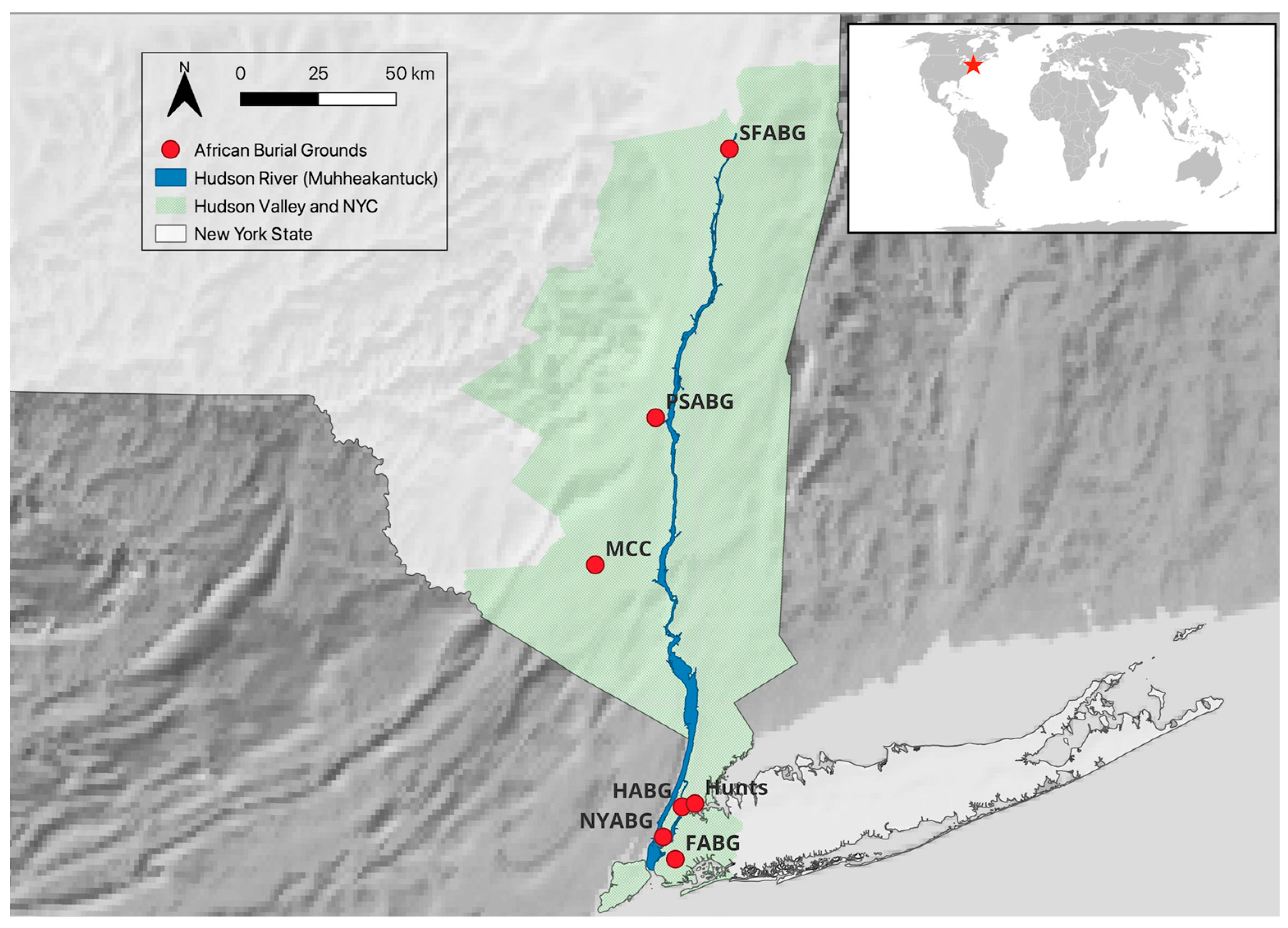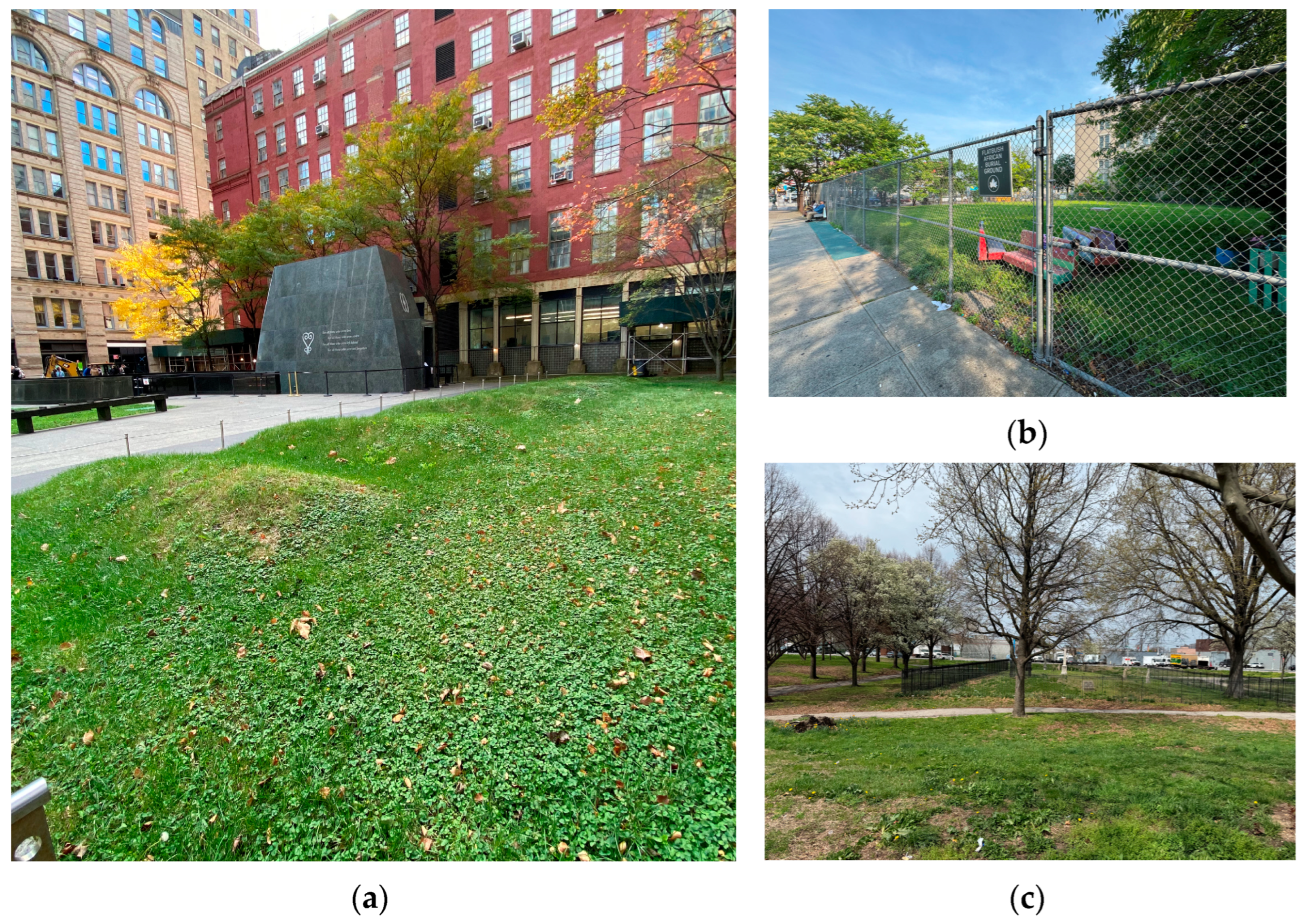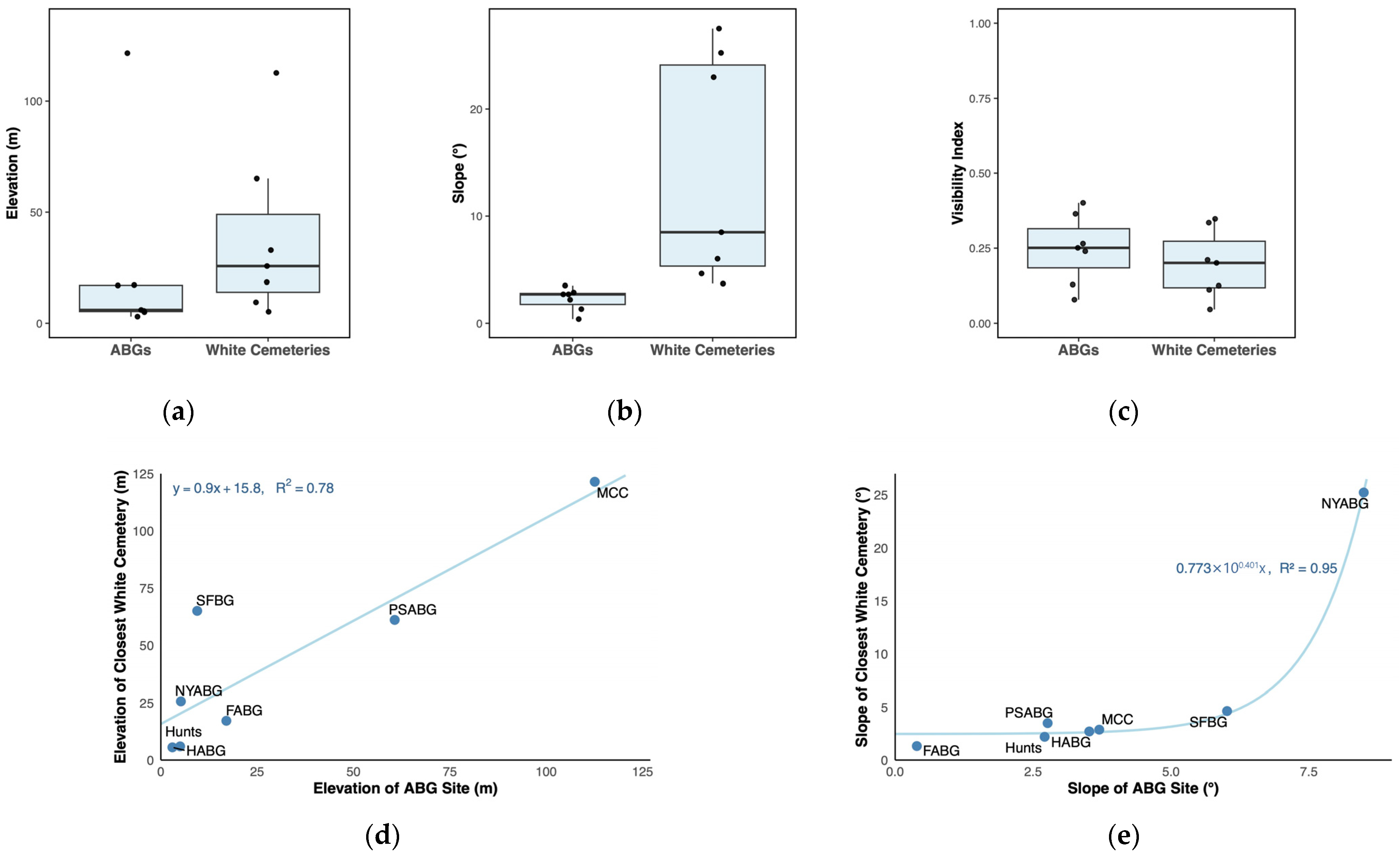Landscape Afterlives: A Geospatial Approach to the History of African Burial Grounds in New York City and the Hudson Valley
Abstract
1. Introduction
Could this melodyBe sung in other countriesBy other birds?
Historical Context: Slavery in Early New York
2. Materials and Methods
2.1. The Sample
2.2. Data Collection
2.3. Analysis
3. Results
4. Discussion
5. Conclusions
Supplementary Materials
Funding
Institutional Review Board Statement
Informed Consent Statement
Data Availability Statement
Conflicts of Interest
Abbreviations
| ABG | African Burial Ground |
| DEM | Digital elevation model |
| GPR | Ground penetrating radar |
| 1 | Take, for instance, the bioarchaeologist Aja Lans for a discussion of the dual role of the skeleton as both “object” and “subject” in bioarchaeological research (Lans, 2018). |
| 2 | Wall Street’s eponymous wall, for example, was constructed mainly by enslaved Africans under the ownership of the Dutch West India Company in 1653 (Moore, 2005). |
References
- Anderson, L. (2009). Update on the Schuyler Flatts burial ground. Legacy: The Magazine of the New York State Museum, 5(1). Available online: https://www.nysm.nysed.gov/research-collections/archaeology/bioarchaeology/research/schuyler-flatts-burial-ground (accessed on 15 December 2024).
- Armstead, M. B. Y. (2003). Mighty change, tall within: Black identity in the Hudson Valley. SUNY Press. [Google Scholar]
- Becker, D., De Andrés-Herrero, M., Willmes, C., Weniger, G.-C., & Bareth, G. (2017). Investigating the influence of different DEMs on GIS-based cost distance modeling for site catchment analysis of prehistoric sites in Andalusia. ISPRS International Journal of Geo-Information, 6(2), 36. [Google Scholar] [CrossRef]
- Brückner, M. (2021). Colonial counter-mappings and the cartographic reformation in eighteenth-century America. XVII–XVIII. Revue de La Société d’études Anglo-Américaines Des XVIIe et XVIIIe Siècles, 78, 78. [Google Scholar] [CrossRef]
- Buis, A. M. (2011). Dutch New York between east & west: The world of Margrieta van Varick. Material Culture Review, 73, 68–77. [Google Scholar]
- Caratzas, M. D. (2023). Joseph Rodman Drake Park and enslaved people’s burial ground (Designation report LP-2674). New York City Landmarks Preservation Commission.
- Danylchak, E., & Cothran, J. R. (2018). Grave landscapes: The nineteenth-century rural cemetery movement. University of South Carolina Press. Available online: https://muse.jhu.edu/pub/244/monograph/book/57039 (accessed on 7 July 2025).
- Deicke, A. (2024, April 8). Spaces of funeral meaning: Modelling socio-spatial relations in burial contexts. CAA 2023—“50 Years of Synergy”. Zenodo. [Google Scholar] [CrossRef]
- Diamond, J. E. (2006). Owned in life, owned in death: The Pine Street African and African-American burial ground in Kingston, New York. Northeast Historical Archaeology, 35(1), 47–62. [Google Scholar] [CrossRef][Green Version]
- Ember, C. R., & Ember, M. (2001). Cross-cultural research methods. Bloomsbury Publishing PLC. [Google Scholar][Green Version]
- FABG Remembrance and Redevelopment Task Force. (2021). Bedford-church community engagement report. New York City Department of Housing Preservation and Development. Available online: https://www.nyc.gov/assets/hpd/downloads/pdfs/services/bedford-church-report.pdf (accessed on 20 July 2025).[Green Version]
- Feller, L. J. (2022). Being indigenous in Jim Crow Virginia: Powhatan people and the color line. University of Oklahoma Press. Available online: https://muse.jhu.edu/pub/350/oa_monograph/book/101132 (accessed on 9 July 2025).[Green Version]
- Frohne, A. E. (2015). The African burial ground in New York city: Memory, spirituality, and space. Syracuse University Press. [Google Scholar][Green Version]
- Goldstein, L. (1981). One-dimensional archaeology and multi-dimensional people: Spatial organisation and mortuary analysis. In R. Chapman, I. Kinnes, & K. Randsborg (Eds.), The archaeology of death (pp. 53–69). Cambridge University Press. Available online: https://d1wqtxts1xzle7.cloudfront.net/48236155/Goldstein_1981-libre.pdf?1471899527=&response-content-disposition=inline%3B+filename%3DOne_dimensional_archaeology_and_multi_di.pdf&Expires=1755557955&Signature=dDXvaM0GTaSZwDc1eBUp0rs5h1W5DF5gMXFrMysmb2GaL32HsN8riPT-T0skpH6OFlj4dcowfS78bl75vs7W1XhHEMZ-YUsM38d58bMjOK3N6nL0M1wJ~iUXh5sRtAePGtSJpic3xSIDJkJdCS3kESaHEs1MpC9JBhWau7HRtDnjpCbw8qG1pRRYF3GGGgyVKP44QLlNvohJe7-z865gCpBKs6~4xhVT35zJXn3jRfyssuKJwDIB2M1UUymBx~kVKqneahDGEpGOLxIYpSi4E3Eysv00fJtmWt8ry6kMP4~qI5x0FTYa6tLE54CU8nQd~m9EihuZGOMdxaXNoHI5ug__&Key-Pair-Id=APKAJLOHF5GGSLRBV4ZA (accessed on 20 July 2025).[Green Version]
- Goodman, A. H., Jones, J., Reid, J., Mack, M. E., Blakey, M. L., Amarasiriwardena, D., Burton, P., & Coleman, D. (2009). Isotopic and elemental chemistry of teeth: Implications for places of birth, forced migration patterns, nutritional status, and pollution. In M. L. Blakey, & L. M. Rankin-Hill (Eds.), The skeletal biology of the New York African burial ground (Vol. 1, pp. 95–118). Howard University Press. [Google Scholar][Green Version]
- Gupta, N., Blair, S., & Nicholas, R. (2020). What we see, what we don’t see: Data governance, archaeological spatial databases and the rights of indigenous peoples in an age of big data. Journal of Field Archaeology, 45(Supp. 1), S39–S50. [Google Scholar] [CrossRef]
- Halverson, J. R. (2016). West African Islam in colonial and antebellum South Carolina. Journal of Muslim Minority Affairs, 36(3), 413–426. [Google Scholar] [CrossRef]
- Harris, L. M. (2003). Slavery in colonial New York. In In the shadow of slavery: African Americans in New York city, 1626–1863 (pp. 11–47). University of Chicago Press. Available online: http://archive.org/details/inshadowofslaver0000harr (accessed on 8 July 2025).
- Harris, L. M. (2004). Slavery, emancipation, and class formation in colonial and early national New York city. Journal of Urban History, 30(3), 339–359. [Google Scholar] [CrossRef]
- Hodges, G. R. G. (2005). Root and branch: African Americans in New York and East Jersey, 1613–1863. University of North Carolina Press. [Google Scholar]
- Jackson, F. L., Mayes, A., Mack, M. E., Froment, A., Keita, S. O., Kittles, R. A., George, M., Shujaa, K. J., Blakey, M. L., & Rankin-Hill, L. M. (2009). Origins of the New York African burial ground population: Biological evidence of geographical and macroethnic affiliations using craniometric, dental morphology, and preliminary genetic analyses. In M. L. Blakey, & L. M. Rankin-Hill (Eds.), The skeletal biology of the New York African burial ground (Vol. 1, pp. 69–94). Howard University Press. [Google Scholar]
- Jacobs, J. (2023). The first arrival of enslaved Africans in New Amsterdam. New York History, 104(1), 96–114. [Google Scholar] [CrossRef]
- Janzen, J. M. (2017). African religion and healing in the Atlantic Diaspora. Oxford Research Encyclopedia of African History, 44–65. [Google Scholar] [CrossRef]
- Kearns, B., & Schneiderman-Fox, F. (2000). Stage 1A archaeological assessment, Bath Rivka School, Flatbush, Brooklyn, New York (Archaeological report 857). New York City Landmarks Preservation Commission. Available online: http://s-media.nyc.gov/agencies/lpc/arch_reports/857.pdf (accessed on 12 December 2024).
- Kwan, R. L.-Y., & Lai, W. W.-L. (2024). Archaeological investigation of burials preluded by ground penetrating radar and geospatial technologies. Journal of Archaeological Science, 170, 106058. [Google Scholar] [CrossRef]
- Lans, A. (2018). “Whatever was once associated with him, continues to bear his stamp”: Articulating and dissecting George S. Huntington and his anatomical collection. In P. K. Stone (Ed.), Bioarchaeological analyses and bodies: New ways of knowing anatomical and archaeological skeletal collections (pp. 11–26). Springer International Publishing. [Google Scholar] [CrossRef]
- Laterman, K. (2019, June 14). This empty lot is worth millions. It’s also an African-American burial ground. The New York Times. Available online: https://www.nytimes.com/2019/06/14/nyregion/african-american-burial-ground-queens-newtown.html (accessed on 15 December 2024).
- Leach, O. (2020, August 20). Historic African American cemetery in montgomery to be restored. Spectrum News. Available online: https://spectrumlocalnews.com/nys/hudson-valley/news/2020/08/20/town-of-montgomery-establishes-committee-to-revitalize-historic-african-american-cemetery (accessed on 9 July 2025).
- Lee, E. J., Anderson, L. M., Dale, V., & Merriwether, D. A. (2009). MtDNA origins of an enslaved labor force from the 18th century Schuyler Flatts Burial Ground in colonial Albany, NY: Africans, native Americans, and Malagasy? Journal of Archaeological Science, 36(12), 2805–2810. [Google Scholar] [CrossRef]
- Leitner, J. (2016). Transitions in the colonial Hudson Valley: Capitalist, Bulk Goods, and Braudelian. Journal of World—Systems Research, 22(1), 214–246. [Google Scholar] [CrossRef]
- Lepore, J. (2005). The tightening vise: Slavery and freedom in British New York. In I. Berlin, & L. M. Harris (Eds.), Slavery in New York (pp. 57–90). The New Press. [Google Scholar]
- Löw, M. (2016). The sociology of space: Materiality, social structures, and action (2nd ed.). Palgrave Macmillan US. Available online: https://content.e-bookshelf.de/media/reading/L-8096072-bf5130e0f8.pdf (accessed on 18 August 2025).
- MacLean, J. S., Conyers, L., & Ottman, S. M. (2017). Hunts Point Burial Ground, Drake Park, Bronx, New York (Phase 1A Documentary Study and Ground Penetrating Radar Survey 1744). New York City Landmarks Preservation Commission.
- Maika, D. J. (2020). To “experiment with a parcel of negros”. Journal of Early American History, 10(1), 33–69. [Google Scholar] [CrossRef]
- Matthews, C. N. (2020). Urban erasures: Historical and contemporary archaeologies. Journal for the Anthropology of North America, 23(1), 4–11. [Google Scholar] [CrossRef]
- Moore, C. P. (2005). A world of possibilities: Slavery and freedom in Dutch New Amsterdam. In I. Berlin, & L. M. Harris (Eds.), Slavery in New York (pp. 29–55). The New Press. [Google Scholar]
- Mosterman, A. C. (2021). Spaces of enslavement: A history of slavery and resistance in Dutch New York. Cornell University Press. [Google Scholar]
- New York City Council. (2024). The New York City Council—File #: Int 1051-2024, Int No 1051-2024. Available online: https://legistar.council.nyc.gov/LegislationDetail.aspx?ID=6874636&GUID=8C163699-6A3D-4733-BB10-90F7118DB2BD&Options=&Search= (accessed on 30 June 2025).
- New York Genealogical & Biographical Society. (1982). Kingston, New York, Old Dutch Church: Burials 1810–1815 (Vol. 113). NYG&B Record. Available online: https://www.newyorkfamilyhistory.org/online-records/nygb-record/566-568/9 (accessed on 7 July 2025).
- Nitsche, F. O., Ryan, W. B. F., Carbotte, S. M., Bell, R. E., Slagle, A., Bertinado, C., Flood, R., Kenna, T., & McHugh, C. (2007). Regional patterns and local variations of sediment distribution in the Hudson River Estuary. Estuarine, Coastal and Shelf Science, 71(1), 259–277. [Google Scholar] [CrossRef]
- Pappalardo, A. M., & Meade, E. D. (2016). Phase 1B archaeological investigation, 126th Street Bus Depot: Block 1803, Lot 1, East Harlem, New York, New York (Phase 1B archaeological investigation 15PR02521; p. 156). New York City Economic Development Corp. [Google Scholar]
- Parditka, G., & Duffy, P. R. (2023). From the ashes of Bronze Age fires: A framework for comparison across body treatments. Journal of Anthropological Archaeology, 71, 101525. [Google Scholar] [CrossRef]
- Pearce, S. C., & Lee, R. (2021). Missing colonies in American myths of slavery: Where is the “Deep North” in sociology textbooks? Sociology of Race and Ethnicity, 7(4), 579–593. [Google Scholar] [CrossRef]
- Radburn, N. (2023). Trans-Atlantic slave trade database. Slave Voyages. Available online: https://www.slavevoyages.org/voyage/database (accessed on 20 September 2024).
- Rothschild, N. A., Sutphin, A., Bankoff, H. A., & MacLean, J. S. (2022). Buried beneath the city: An archaeological history of New York. Columbia University Press. [Google Scholar] [CrossRef]
- Sandy, W. (2024). Archaeology of the montgomery “Colored” cemetery (p. 6). Walden Juneteenth Celebration. [Google Scholar]
- Sanjek, R. (2000). The future of us all: Race and neighborhood politics in New York city. Cornell University Press. [Google Scholar]
- Schneiderman-Fox, F., Crist, T., Dickinson, N., Kearns, B., Mascia, S., & Saunders, C. (2001). Stage 1B archaeological investigation, P.S. 325-K, Church and Bedford Avenues, Brooklyn, New York (Archaeological report 858). New York City Landmarks Preservation Commission.
- Sharples, J. T. (2020). The world that fear made: Slave revolts and conspiracy scares in early America. University of Pennsylvania Press. [Google Scholar]
- Smith, D. E. (2016). Governing data and data for governance: The everyday practice of Indigenous sovereignty. In T. Kukutai, & J. Taylor (Eds.), Indigenous data sovereignty: Toward an agenda. ANU Press. [Google Scholar] [CrossRef]
- Spera, S. A., Franklin, M. S., Zizzamia, E. A., & Smith, R. K. (2022). Recovering a Black cemetery: Automated mapping of hidden gravesites using an sUAV and GIS in east end cemetery, Richmond, VA. International Journal of Historical Archaeology, 26(4), 1110–1131. [Google Scholar] [CrossRef]
- SSURGO. (2025). SSURGO [Dataset]. Available online: https://websoilsurvey.sc.egov.usda.gov/App/HomePage.htm (accessed on 9 July 2025).
- Stanne, S. P., Panetta, R. G., Forist, B. E., & Niemisto, M. L. (2021). The Hudson: An illustrated guide to the living river (3rd ed.). Rutgers University Press. [Google Scholar] [CrossRef]
- Starr, P. (2023). The Re-Emergence of “People of Color”. Du Bois Review: Social Science Research on Race, 20(1), 1–20. [Google Scholar] [CrossRef]
- Stiles, H. (2012). History of the city of Brooklyn. Applewood Books. [Google Scholar]
- Tilton, E. (1910). The reformed low Dutch Church of Harlem, organized 1660: Historical sketch. Consistory. [Google Scholar]
- U.S. General Services Administration. (1993). New York African Burial Ground [National Register of Historic Places Registration Form] (p. 43). National Park Service/General Services Administration. Available online: https://npgallery.nps.gov/GetAsset/bd7edd66-f641-4d5f-b0ac-e92077fef27f (accessed on 3 July 2025).
- Wescott, D. J. (2018). Recent advances in forensic anthropology: Decomposition research. Forensic Sciences Research, 3(4), 327–342. [Google Scholar] [CrossRef] [PubMed]
- White, S. (1995). Slavery in New York state in the early republic. Australasian Journal of American Studies, 14(2), 1–29. [Google Scholar]
- White, S. (2012). Somewhat more independent: The end of slavery in New York city, 1770–1810. University of Georgia Press. [Google Scholar]
- Williams, R. L. (1999). Montgomery, New York. Arcadia Publishing. [Google Scholar]
- Woods, L. (2019, February 18). Kingston groups hurrying to buy site of 250-year-old African-American cemetery—Hudson Valley One. Available online: https://hudsonvalleyone.com/2019/02/18/kingston-groups-hurrying-to-buy-site-of-250-year-old-african-american-cemetery/ (accessed on 2 July 2025).
- Wright, R. (2011). Haiku: This other world. Skyhorse Publishing Company, Incorporated. [Google Scholar]
- Zoran. (2020, May 1). Visibility index (total viewshed) for QGIS. Landscape Archaeology. Available online: https://landscapearchaeology.org/2020/visibility-index/ (accessed on 16 December 2024).



| Site | Estimated Date of First Interment | Location | State of Archaeological Preservation | Legal Protections |
|---|---|---|---|---|
| Flatbush African Burial Ground (FABG) | 1780s | Kings County (Brooklyn) | Disturbed (some excavation) | None |
| Harlem African Burial Ground (HABG) | 1660s | East Harlem | Disturbed (some excavation) | None |
| Hunts Point Enslaved African Burial Ground | 1729 | The Bronx | Disturbed (not excavated) | None |
| Montgomery “Colored Cemetery” (MCC) | 1756 | Orange County | Undisturbed (surveyed but not excavated) | National Register of Historic Places |
| New York African Burial Ground (NYABG) | 1690s | Lower Manhattan | Excavated (salvage excavation) | National monument |
| Pine Street African Burial Ground (PSABG) | 1660s * | Ulster County | Largely undisturbed (unexcavated) | Land trust (conservation easement) |
| Schuyler Flatts African Burial Ground (SFABG) | 1690s * | Albany County | Excavated (salvage excavation) | None |
| Site | Mean Elevation (masl) | Mean Slope (°) | Mean Visibility Index | AWS to 150 cm Depth (cm3) | Mean Annual Precipitation (mm) |
|---|---|---|---|---|---|
| FABG (Nearest white cemetery) | 17.2 (113) | 1.33 (3.70) | 0.365 (0.211) | 7.07 (7.07) | 1196 (1196) |
| HABG (Nearest white cemetery) | 17.0 (25.7) | 0.393 (25.2) | 0.129 (0.125) | 4.92 (7.07) | 1196 (1196) |
| Hunts Point ABG (Nearest white cemetery) | 5.57 (18.5) | 2.71 (23.0) | 0.240 (0.348) | 0.81 (9.38) | 1196 (1196) |
| MCC (Nearest white cemetery) | 3.00 (32.9) | 3.52 (27.5) | 0.251 (0.201) | 31.6 (10.33) | 1080 (1168) |
| NYABG (Nearest white cemetery) | 6.00 (5.20) | 2.20 (8.49) | 0.0788 (0.0463) | 4.92 (4.92) | 1196 (1196) |
| PSABG (Nearest white cemetery) | 5.00 (65.10) | 2.71 (4.64) | 0.401 (0.335) | 14.46 (14.46) | 1168 (1168) |
| SFABG (Nearest white cemetery) | 121 (9.44) | 2.88 (6.01) | 0.265 (0.112) | 13.7 (24.33) | 965 (965) |
Disclaimer/Publisher’s Note: The statements, opinions and data contained in all publications are solely those of the individual author(s) and contributor(s) and not of MDPI and/or the editor(s). MDPI and/or the editor(s) disclaim responsibility for any injury to people or property resulting from any ideas, methods, instructions or products referred to in the content. |
© 2025 by the author. Licensee MDPI, Basel, Switzerland. This article is an open access article distributed under the terms and conditions of the Creative Commons Attribution (CC BY) license (https://creativecommons.org/licenses/by/4.0/).
Share and Cite
Wang Gaouette, S. Landscape Afterlives: A Geospatial Approach to the History of African Burial Grounds in New York City and the Hudson Valley. Humans 2025, 5, 25. https://doi.org/10.3390/humans5040025
Wang Gaouette S. Landscape Afterlives: A Geospatial Approach to the History of African Burial Grounds in New York City and the Hudson Valley. Humans. 2025; 5(4):25. https://doi.org/10.3390/humans5040025
Chicago/Turabian StyleWang Gaouette, Sebastian. 2025. "Landscape Afterlives: A Geospatial Approach to the History of African Burial Grounds in New York City and the Hudson Valley" Humans 5, no. 4: 25. https://doi.org/10.3390/humans5040025
APA StyleWang Gaouette, S. (2025). Landscape Afterlives: A Geospatial Approach to the History of African Burial Grounds in New York City and the Hudson Valley. Humans, 5(4), 25. https://doi.org/10.3390/humans5040025






